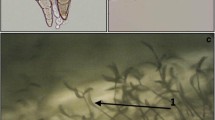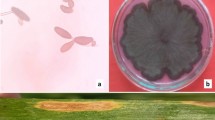Abstract
An in vitro detached leaf assay, involving the inoculation of detached leaves with Microdochium nivale, was further developed and used to compare with whole plant resistance ratings to Fusarium head blight (FHB) of 22 commercial cultivars and published information on 21 wheat genotypes, identified as potential sources for FHB resistance. An incubation temperature of 10 °C and isolates of M. nivale var. majus of intermediate pathogenicity were found to be the most suitable for the differential expression of several components of partial disease resistance (PDR), namely incubation period, latent period and lesion length, in wheat genotypes used in the detached leaf assay. There were highly significant differences (P < 0.001) for each component of PDR within commercial cultivars and CIMMYT genotypes. Positive correlations were found between incubation period and latent period (r = 0.606; P < 0.001 and r = 0.498; P < 0.001, respectively, for commercial cultivars and CIMMYT genotypes), inverse correlations between incubation period and lesion length (r = -0.466; P < 0.01 and r = −0.685; P < 0.001, respectively) and latent period and lesion length (r = −0.825; P < 0.001 and r = −0.848; P < 0.001, respectively). Spearman rank correlations between individual PDR components and UK 2003 recommended list ratings were significant for incubation period (rs = 0.53; P < 0.05) and latent period (rs = 0.70; P < 0.01) but not for lesion length (r s = −0.26). Commercial cultivars identified with high resistances across all three PDR components in the detached leaf assay also had high whole plant FHB resistance ratings, with the exception of cv. Tanker which is more susceptible than the results of the detached leaf assay suggested, indicating an additional susceptibility factor could be present. Agreement between resistances found in the detached leaf assay and resistance to FHB suggests resistances detected in detached leaves are under the same genetic control as much of the resistances expressed in the wheat head of the commercial cultivars evaluated. In contrast, high resistances in each of the PDR components were associated with higher susceptibility across 19 CIMMYT genotypes previously evaluated as potential breeding sources of FHB resistance (incubation period: r = 0.52; P < 0.01, latent period: r = 0.53; P < 0.01, lesion length: r = −0.49; P < 0.01). In particular, the CIMMYT genotypes E2 and E12 together with Summai #3, known to have high levels of whole plant FHB resistance, showed low levels of resistance in each PDR component in the detached leaf assay. Such whole plant resistances, which are highly effective and not detected by the detached leaf assay, do not appear to be present in Irish and UK commercial cultivars. The most resistant Irish and UK commercial cultivars were comparable to the genotype Frontana and the most resistant CIMMYT germplasm evaluated in the leaf assay.
Similar content being viewed by others
References
Browne RA and Cooke BM (2004) A new method for producing mycelium-free conidial suspensions from cultures of Microdochium nivale. European Journal of Plant Pathology 110: 87-90
Bruehl GW (1967) Fusarium head blight or scab. In: Reitz LP and Queensbury KS (eds) Wheat and Wheat Improvement (pp 388-390) American Society of Agronomy, Madison, Wisconsin
Bruins MBM, Karsai I, Schepers J and Snijders CHA (1993) Phytotoxicity of deoxynivalenol to wheat tissue with regard to an in vitro selection for Fusarium head blight resistance. Plant Science 94: 195-206
Buerstmayr H, Lemmens M, Grausgruber H and Ruckenbauer P (1996) Breeding for scab resistance in wheat: Inheritance of resistance and possibilities for in vitro selection. In: Proceedings of theWorkshop on Fusarium Head Scab: Global Status and Future Prospects (pp 52-58) CIMMYT, Mexico
Chen P, Liu D and Sun W (1997) New countermeasures of breeding for scab resistance. In: Duben HJ, Gilchrist L, Reeves J and McNab A (eds) Fusarium Head Scab: Global Status and Future Prospects (pp 59-65) CIMMYT, Mexico, DF
Cooke BM (1980) The use of coolplates for culturing photosporogenetic fungi. Bulletin of the British Mycological Society 14: 137-138
Cook RJ (1981) Fusarium diseases of wheat and other small-grains in North America. In: Nelson PE, Toussoun TA and Cook RJ (eds) Fusarium: Diseases, Biology and Taxonomy (pp 39-52) The Pennsylvania State University Press, University Park, 457 pp
Dardis JV (2000) Development and evaluation of genetic and chemical strategies for the control of Fusarium head blight in bread wheat. PhD thesis, University College, Dublin
Dardis JV and Walsh EJ (2003) An evaluation of exotic germplasm as sources of Fusarium head blight resistance in bread wheat. Cereal Research Communications 31: 129-136
Diamond H and Cooke BM (1997) Host specialisation in Microdochium nivale on cereals. Cereal Research Communications 25: 533-538
Diamond H and Cooke BM (1999) Towards the development of a novel in vitro strategy for early screening of Fusarium ear blight resistance in adult winter wheat plants. European Journal of Plant Pathology 105: 363-372
Lijuan G, Qingxiao Y, Qide H, Hao Z, Fuyou D, Huaquan Z and Wufang H (1991) Studies on screening the resistant mutants of wheat to Fusarium graminearum by tissue culture. Genetic Manipulations of Plants 7: 25-33
Mesterhazy A (1987) Selection of head blight resistant wheats through improved seedling resistance. Plant Breeding 98: 25-36
Mesterhazy A (1989) Progress in breeding of wheat and corn genotypes not susceptible to infection by Fusaria. In: Chelkowski J (ed) Fusarium Mycotoxins, Taxonomy and Pathogenicity (pp 357-386) Elsevier, Amsterdam
Mesterhazy A (1995) Types and components of resistance against Fusarium head blight of wheat. Plant Breeding 114: 377-386
Mesterhazy A, Bartok T, Mirocha CG and Komoroczy R (1999) Nature of wheat resistance to Fusarium head blight and the role of deoxynivalenol for breeding. Plant Breeding 118: 97-110
Mesterhazy A (2002) Role of deoxynivalenol in aggressiveness of Fusarium graminearum and F. culmorum and in resistance to Fusarium head blight. European Journal of Plant Pathology 108: 675-684
Miedaner T (1997) Breeding wheat and rye for resistance to Fusarium diseases-a review. Plant Breeding 116: 201-220
Miller JD and Arnison PG (1986) Degradation of deoxynivalenol by suspension cultures of Fusarium head blight resistant wheat cultivar Frontana. Canadian Journal of Plant Pathology 8: 147-150
Parry DW, Jenkinson P and McLeod L (1995) Fusarium ear blight (scab) in small grain cereals-a review. Plant Pathology 44: 207-238
Ruckenbauer P, Buerstmayr H and Lemmens M (2001) Present strategies in resistance breeding against scab (Fusarium spp.). Euphytica 119: 121-127
Schroeder HW and Christensen JJ (1963) Factors affecting resistance of wheat to scab caused by Gibberella zeae. Phytopathology 53: 831-838
Singh RP and van Ginkel M (1997) Breeding strategies for introgressing diverse scab resistance into adapted wheats. In: Duben HJ, Gilchrist L, Reeves J and McNab A (eds) Fusarium Head Scab: Global Status and Future Prospects (pp 86-92) CIMMYT, Mexico, DF
Snijders CHA (1990) Genetic variation for resistance to Fusarium head blight in bread wheat. Euphytica 50: 171-179
Wakulinski W (1989) Phytotoxicity of the secondary metabolites of fungi causing wheat head fusariosis (head blight). Acta Physiologiae Plantarum 11: 301-306
Wang YZ and Miller JD (1988) Effects of metabolites on wheat tissue in relation to Fusarium head blight resistance. Journal of Phytopathology 122: 118-125
Author information
Authors and Affiliations
Rights and permissions
About this article
Cite this article
Browne, R., Cooke, B. Development and Evaluation of an in vitro Detached Leaf Assay forc Pre-Screening Resistance to Fusarium Head Blight in Wheat. European Journal of Plant Pathology 110, 91–102 (2004). https://doi.org/10.1023/B:EJPP.0000010143.20226.21
Issue Date:
DOI: https://doi.org/10.1023/B:EJPP.0000010143.20226.21




